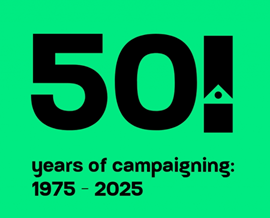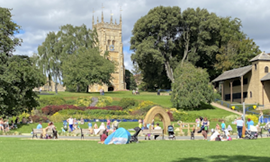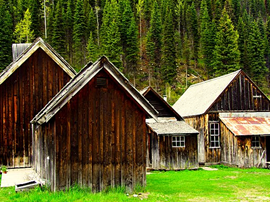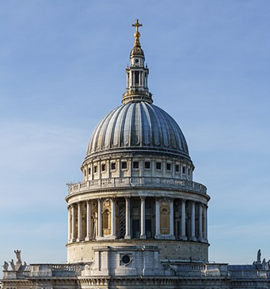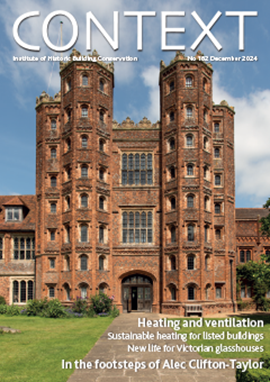Gentrification in London
Changing socio-economic conditions have contributed to a range of different forms of gentrification, some of which threaten the creativity and diversity that make London special.
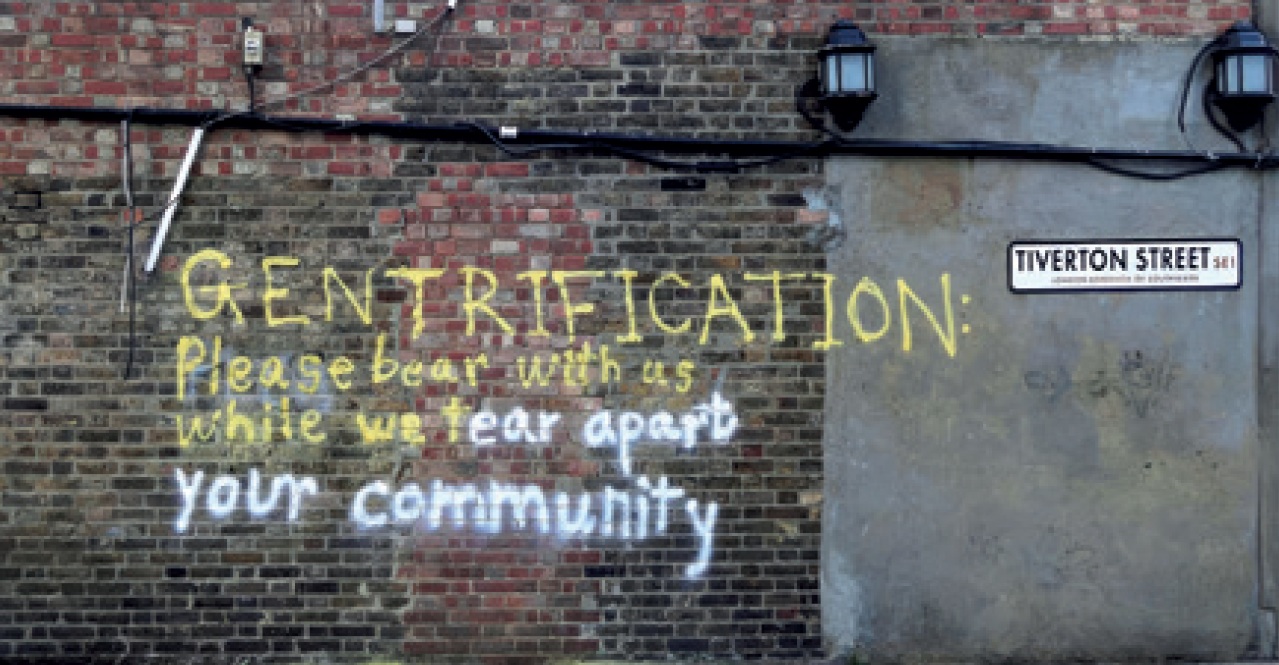
|
| Anti-gentrification graffiti in Tiverton Street, near Newington Causeway, in 2015 (Photo: themostinept via Flickr). |
Contents |
Introduction
Though there are historic antecedents, gentrification as we think of it today is a post-war phenomenon, closely linked to improvements in health, standards of living and levels of income in British society. Hugely significant was the post-war decline of industry, and consequently the disintegration and almost total disappearance of the capital’s industrial working class and its culture. Into the vacuum left behind came a changed inner-city employment structure with an emergent service sector and growth in office development, mostly populated by a better-educated and better-off middle class. Other than the effects of the second world war, it is the recolonisation of former working-class areas by these middle-class professionals that has been the single biggest influence on the residential composition of inner London in the 20th and 21st centuries.
Early ‘organic’ gentrification
The well-known, ‘classic’ early phase of gentrification first became evident on a large scale in the 1960s and 70s, when young, affluent professionals, priced out of established upper-middle- class areas like Hampstead, Highgate or Chelsea, began moving to other convenient but often poorer areas, buying up and restoring the generally rundown period houses there. This process is often referred to as ‘organic’ gentrification, as it differs conceptually from more recent examples in areas like Docklands, and was reliant on the rehabilitation of existing housing stock by individual homeowners, rather than large-scale redevelopment.
The areas that these pioneer gentrifiers populated are also well-known: Islington, Camden, Hackney in north London, Battersea and Clapham south of the river. Their attractions were several. Usually, they were on the fringe of an already socially acceptable area – what you might term ‘spillover’ gentrification. These districts often had a sense of independence or detachment from less salubrious areas. For instance, the most exclusive parts of south Battersea around Lavender Hill and ‘Between the Commons’, where gentrification took hold in the Thatcherite 1980s and never let go, are completely cut off from the council estates and tower blocks of north Battersea by the broad swathe of east-west train tracks running in and out of Clapham Junction. The presence of Clapham Junction highlights another prerequisite for gentrification: good transport links, preferably by train or tube (Battersea has both), for access to professional hotspots like the City.
It was period housing that supported this form of gentrification. In more central or older districts like Chelsea or Clapham there were run-down Georgian houses but further out in later suburbs it was the supply of good, solidly built Victorian and Edwardian houses that attracted gentrifiers. These had been run up quickly to deal with rapid population growth as the railways and industrialisation transformed the Victorian city. Many would have been in multiple occupation and were often designed with that in mind; the important thing for the pioneer gentrifiers was that they were cheap to buy and easily converted back to single family homes, with capacity for improvements like new bathrooms and kitchens to suit modern lifestyles. It is the availability and suitability for gentrification of this stock of old, low-rise housing which is found all over the capital, that marks London out from other major cities in Europe and North America, where gentrification tended to occur in former industrial areas or along disused waterfronts.
Who were these early gentrifiers and for how long did they stay? To begin with many were university educated, middle-class people in cultural professions – artists, writers, architects, teachers, academics, also civil servants and lawyers – people who appreciated the urban environment. In fact, many of the factors that had driven more mainstream middle classes out of cities were attractive to them, such as old houses, crowded streets, social and cultural diversity, greater tolerance and openness. Many were young, either childless or with very young children and so often stayed only a few years before moving further out to larger properties with bigger gardens for the next phases of the family lifecycle.
While they were there, that sense of history and the architectural style of their houses became a stage for the display of wealth and taste. This was evident in the changes that the gentrifiers made, exposing or restoring cornices, tiled fireplaces or ceiling roses, and searching out suitable pieces in salvage yards. Gentrifiers became a force in local amenity groups and societies, and one of the benefits of the process was in building conservation. The 1960s was when this took off in London, and when local government began to move away from clearance and redevelopment to reinstatement, supporting homeowners who wished to make improvements through grants. This mode of gentrification probably saved much of London’s outdated inner-city housing from demolition, helping to preserve the historic urban character of these areas.
The most visible impact was the change in local shops and facilities. Upmarket bars and cafes sprang up to meet the requirements of the new residents, old pubs became gastropubs and branded coffee shops and estate agents began to litter the high streets. All of this and the brash, conspicuous levels of consumption were beyond the means of the remaining indigenous lower-middle and working classes, and were a manifestation of a growing inequality.
The principal disadvantage of this kind of social change is the displacement of the working classes, and a reversal of previous trends, with the poor increasingly moving out to the suburbs. Changes in tenure, from a rental market to a predominantly house-buying one, reduced the number of available affordable rental properties. The only way for the working class to remain was through council or social housing, the persistence of which has limited gentrification, holding back homogenisation and ensuring that lower-income households can still live in central areas of the city.
This process is still happening today, for example in Hoxton, Stoke Newington, Elephant and Castle and Peckham Rye, and if it continues there will soon be very little run-down historic housing stock in inner London left to gentrify.
State or developer-led gentrification
In the 1970s and 80s a very different kind of gentrification emerged, whereby entire working-class and formerly industrial areas were redeveloped as new neighbourhoods of expensive private homes and luxury office blocks. The difference here was that change was initiated not by individual ‘gentrifiers’ but by property developers and national or local governments working together.
The Isle of Dogs is the classic example of this, where the Thatcher government removed all the standard planning controls to create a so-called ‘enterprise zone’ and encourage investment and redevelopment on a vast scale. This rapid second wave of gentrification was made possible by London’s emergence as a leading financial centre in the 1980s, especially after the deregulation of the Stock Exchange and internationalisation of securities dealing. These brought an expansion in City employment and waves of finance workers moving to these newly built gentrified areas – a far wealthier group than the pioneer gentrifiers.
Whitechapel has also seen dramatic change in the last 20 years and at a bewildering rate, particularly at its western end where it abuts the City, with clusters of new-build offices, flats and hotels entirely changing the character of this historic East End district. Free-school meal eligibility here (a reliable indicator of poverty) was the highest anywhere in London in 2010 but has since fallen considerably, suggesting social change. A primary school built in Whitechapel in 1985 closed in 2021, there being too few children left locally to sustain it.
Super-gentrification
Changing socio-economic factors over the past 20 years or so have contributed to a new strand of gentrification – what has been called ‘regentrification’, or ‘hyper-gentrification’, or, more commonly, ‘super-gentrification’ – whereby a new upper stratum of super-rich residents is taking over parts of London already gentrified, initiating a further cycle of change. With the stock of suitable houses or areas already exhausted, there is no alternative now for the super-rich but to re-gentrify those which have already been through the process.
Who are these people? Much of this super-gentrification is fuelled by the great wealth now generated by the City, with the internationalisation of City salaries, a bonus culture and new high-earning financial products, hedge funds and private equity firms. And there is a second, even richer group of foreign oligarchs, multibillionaire industrialists and global financiers with new extremes of wealth, ready to pay unthinkable sums for London houses. Nearly half of London property sales in 2020 went to overseas buyers, and a study in 2015 found London is the world’s top location for the super-rich, with nearly 4,500 individuals here with $30 million or more in assets.
Where is this super-gentrification happening, and what are its consequences? The big magnets are the already elite central London districts like St James’s, Mayfair, Regent’s Park, Belgravia, Knightsbridge, Kensington, Notting Hill and Chelsea. But there are discernible differences here from the pioneer gentrification of the 1970s–80s. For instance, in terms of their treatment of the building fabric, the early gentrifiers, as we have seen, often came from liberal, humanities-educated backgrounds and generally appreciated the historical aspect of their houses and restored them with a degree of respect. The new supergentrifiers from global finance seem to have less interest in period aesthetics; their usual modus operandi is to rip out existing fabric, build extensions to allow more space for ultramodern interiors and excavate basements for private gyms, cinemas or swimming pools. For them, location is the key factor.
Another difference from previous waves of gentrification is a lack of engagement with local communities. Early gentrifiers would often send their children to local schools, use local shops and so on; the new super-gentrifiers tend not to invest in or support local services. They operate outside the traditional British class system and existing cultural and social infrastructures. They have their own economy, whereby capital is invested in their housing and facilities like security firms, domestic service and private education. Very little of the money they bring is fed back into the local community.
For the super-rich, the house is no longer simply a place to live but another investment or tradeable asset; a vehicle for wealth accumulation – a store for global money. In recent years this attitude has created a new buy-to-leave phenomenon, where the super-rich overseas buyers purchase prime London property at high prices with little intention of living there. This financialisation of housing further drives up other house prices, making it even more difficult for everyone else further down the food chain.
Displacement also still takes place as a result, in this case not of the poor but of the previously well-off residents who used to dominate such areas. They then have to move further out, driving up prices in other parts of the capital. There is a threat to the vitality of these urban neighborhoods. Parts of Kensington and Chelsea are now ‘dead zones’, with empty houses patrolled by security guards and little in the way of street life. Corner shops and pubs close, community life breaks down. The danger is that, as in other global cities, the very creativity and diversity that made London special and attracted wealth to come here in the first place will disappear.
This article originally appeared in the Institute of Historic Building Conservation’s (IHBC’s) Context 181, published in September 2024. It was written by Colin Thom, director of the Survey of London, the leading reference work on the history and architecture of the city. Since 2013, the Survey has been part of the Bartlett School of Architecture at University College London (UCL), where Thom also teaches architectural history and theory.
--Institute of Historic Building Conservation
Related articles on Designing Buildings Conservation.
- Central business district (CBD).
- Conservation.
- Densification.
- Edge Debate 71 - Can decentralisation solve the housing crisis?
- Gentrification.
- Heritage.
- Historic environment.
- IHBC articles.
- Institute of Historic Building Conservation.
- Must cities grow to compete?
- Regeneration.
- Social housing.
- Suburb.
- The compact sustainable city.
- Urban decay.
- Urban sprawl.
IHBC NewsBlog
SAVE celebrates 50 years of campaigning 1975-2025
SAVE Britain’s Heritage has announced events across the country to celebrate bringing new life to remarkable buildings.
IHBC Annual School 2025 - Shrewsbury 12-14 June
Themed Heritage in Context – Value: Plan: Change, join in-person or online.
200th Anniversary Celebration of the Modern Railway Planned
The Stockton & Darlington Railway opened on September 27, 1825.
Competence Framework Launched for Sustainability in the Built Environment
The Construction Industry Council (CIC) and the Edge have jointly published the framework.
Historic England Launches Wellbeing Strategy for Heritage
Whether through visiting, volunteering, learning or creative practice, engaging with heritage can strengthen confidence, resilience, hope and social connections.
National Trust for Canada’s Review of 2024
Great Saves & Worst Losses Highlighted
IHBC's SelfStarter Website Undergoes Refresh
New updates and resources for emerging conservation professionals.
‘Behind the Scenes’ podcast on St. Pauls Cathedral Published
Experience the inside track on one of the world’s best known places of worship and visitor attractions.
National Audit Office (NAO) says Government building maintenance backlog is at least £49 billion
The public spending watchdog will need to consider the best way to manage its assets to bring property condition to a satisfactory level.
IHBC Publishes C182 focused on Heating and Ventilation
The latest issue of Context explores sustainable heating for listed buildings and more.







